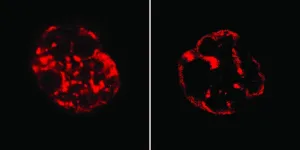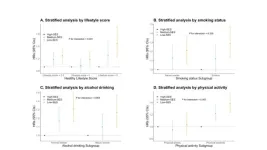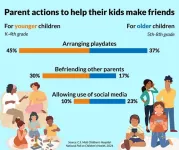(Press-News.org) Discovery expands understanding of how language is produced by the brain
Current method of mapping brain language function for surgery using electrical stimulation hasn’t changed in 50 years
Finding could make it easier on patients and doctors to identify critical language sites in the brain to preserve function after surgery
CHICAGO --- When surgeons perform brain surgery on people with brain tumors or epilepsy, they need to remove the tumor or abnormal tissue while preserving parts of the brain that control language and movement.
A new Northwestern Medicine study may better inform doctors’ decisions about which brain areas to preserve, thereby improving patients’ language function after brain surgery. The study expands the understanding of how language is encoded in the brain and identifies key features of critical sites in the cerebral cortex that work together to produce language.
If you think of the brain’s language network as a social network, scientists have essentially found the person who is the link between lots of subnetworks of people. They wouldn’t know each other if not for this single person. In the brain, these “connectors” serve the same function for language. If the connector sites were removed, the patient would make more language errors after surgery — such as difficulty naming objects — because the subnetworks couldn’t work together.
The study will be published Sept. 16 in Nature Communications.
Brain signals from patients with brain tumors and epilepsy
Northwestern scientists identified the critical language connector sites by recording electrical signals from the cortex of the brain in patients with epilepsy or brain tumors while the patients read words aloud. Investigators then analyzed the signals using graph theory methods and machine learning to predict which sites in the network were critical.
“This discovery could help us be more precise and efficient when we’re mapping language sites before surgery,” said corresponding author Dr. Marc Slutzky, professor of neurology at Northwestern University Feinberg School of Medicine and a Northwestern Medicine neurologist. “It could help us augment the way surgeons do this mapping, so ultimately it could potentially shorten the time needed for stimulation or possibly eliminate the stimulation and just record electrical signals.”
People with brain tumors or epilepsy who need surgery often undergo functional mapping using direct electrical stimulation of the brain to try to identify critical parts of the brain (particularly in the cerebral cortex) so neurosurgeons know which sites to avoid removing to preserve language. For example, the electrical stimulation might temporarily interrupt the ability to speak or conceive of names for objects, which would suggest that the area to which stimulation was applied is important to speech or to language function.
Current stimulation technique has limitations
“The way this is done hasn’t changed significantly in over 50 years, yet exactly what is happening during this stimulation is still not well understood,” Slutzky said. “It is not clear what is special about the focal sites identified by stimulation as critical to language and speech.
“When someone is speaking, many sites in the brain are active, yet only a handful of those sites are identified as critical to those functions by being perturbed during stimulation. Answering this question could help us understand how electrical stimulation affects the brain and how the brain produces spoken language.”
An estimated 1.2 million people in the U.S. are living with brain tumors
Currently, many patients with brain tumors undergo between 20 and 60 minutes of stimulation time while they are awake in surgery. The technique is not perfect for identifying the language sites: results can be false negative or false positive, and the process can cause seizures.
“It’s not fun for the patient,” Slutzky said. “When we do it for epilepsy patients, the mapping can take a day or sometimes two and is exhausting for them.”
Epilepsy patients may need brain surgery when medications don’t adequately control seizures, Slutzky said.
How the study worked
Scientists recorded electrical signals from the surface of the cortex in 16 patients (at Northwestern Memorial Hospital and at Johns Hopkins Hospital) with either epilepsy or brain tumors. The electrode arrays were either implanted in people with epilepsy as part of their seizure monitoring prior to surgery or placed on the brain temporarily in the operating room, while patients with tumors underwent awake brain surgery and mapping.
The patients read single words aloud from a monitor while investigators recorded their brain signals (called electrocorticography). Scientists then analyzed the signals using metrics from graph theory, a branch of mathematics focused on networks. (Graph theory also is used to analyze all kinds of networks, including social networks, which is how many internet search engines work.) These network metrics described how much each site was functionally connected, either locally (with nearby sites), globally (with all sites recorded) or across communities (subnetworks). Scientists then used machine learning to predict which sites in the network were critical using only the network metrics. Critical sites tended to be those that connected across communities.
Other Northwestern study authors are Jason K. Hsieh, Prashanth R. Prakash, Robert D. Flint, Zachary Fitzgerald, Emily Mugler, Jessica W. Templer, Joshua M. Rosenow and Matthew C. Tate.
The Northwestern research was a collaboration between Nathan Crone and Yujing Wang at Johns Hopkins University (department of neurology) and Richard Betzel at Indiana University (department of psychological and brain sciences).
END
Vital language sites in brain act like connectors in a social network
Scientists discover key features of language sites that could help preserve function after brain surgery
2024-09-16
ELSE PRESS RELEASES FROM THIS DATE:
Astronomers detect black hole ‘starving’ its host galaxy to death
2024-09-16
Astronomers have used the NASA/ESA James Webb Space Telescope to confirm that supermassive black holes can starve their host galaxies of the fuel they need to form new stars.
The international team, co-led by the University of Cambridge, used Webb to observe a galaxy roughly the size of the Milky Way in the early universe, about two billion years after the Big Bang. Like most large galaxies, it has a supermassive black hole at its centre. However, this galaxy is essentially ‘dead’: it has mostly stopped forming new stars.
“Based ...
Is CREME AI’s answer to CRISPR?
2024-09-16
Imagine you’re looking at millions upon millions of mysterious genetic mutations. With CRISPR gene-editing technology, a select few of these mutations might have therapeutic potential. However, proving it would mean many thousands of hours of lab work. Just figuring out which ones are worth exploring further would take a lot of time and money. But what if you could do it in the virtual realm with artificial intelligence?
CREME is a new AI-powered virtual laboratory invented by Cold Spring Harbor Laboratory (CSHL) Assistant Professor Peter Koo and his team. It allows geneticists to run thousands of virtual experiments ...
Interrelated social factors may affect cardiovascular health in Asian American subgroups
2024-09-16
Statement Highlights:
There are a variety of interrelated social and structural factors that contribute to differences in cardiovascular health among Asian Americans, and these factors are likely different within individual Asian ethnic subgroups.
Asian Americans and Asian immigrants are quite diverse and comprise many ethnic groups.
Social determinants, such as immigration-related factors, discrimination, socioeconomic status, English proficiency and cultural beliefs, may influence health behaviors, access to health care and the ability ...
New insights into DNA organization during embryonic development
2024-09-16
Researchers from the Kind Group have gained new insights into the mechanism behind the spatial organization of DNA within the cells of early embryos. When an embryo is first formed after fertilization, each cell has the potential to become any cell type of the body. The researchers have studied the spatial organization of DNA that is so particular to these early developmental stages. The paper was published in Nature Genetics on September 16th, 2024.
Every cell in our body contains the same DNA. ...
Socioeconomic inequality linked to increased risk of age-related macular degeneration
2024-09-16
A recent study conducted by researchers from Shanghai Jiao Tong University School of Medicine and Fudan University has revealed a significant association between socioeconomic status (SES) inequality and the risk of developing age-related macular degeneration (AMD). Published in Health Data Science, the study highlights how a healthy lifestyle can mitigate some of the risks associated with low SES.
Socioeconomic disparities have long been a concern in various health outcomes. This study, led ...
Cow slime can help disc herniation patients after surgery
2024-09-16
Researchers at Uppsala University have developed a gel inspired by cow slime for patients suffering from disc herniation. By adding the mucin gel immediately after surgery, it is possible to create a protective barrier around the discs to prevent the immune system from attacking their nucleus pulposus. This keeps the discs intact and reduces the risk of further damage.
“This new approach offers hope for those suffering from back pain caused by disc herniation and may prevent further damage after removing ...
1 in 5 parents worry their elementary and middle school aged kids don’t have friends
2024-09-16
ANN ARBOR, Mich. – Developing friendships is often seen as a natural part of childhood but it may be easier for some kids than others.
And many parents worry about their children’s friendships, according to the University of Michigan Health C.S. Mott Children’s Hospital National Poll on Children’s Health, with one in five saying their child ages six to 12 has no friends or not enough friends.
Ninety percent of parents believe their child would like to make new friends.
“Friendships can play a significant role in children’s overall health and development, emotional well-being, ...
AI-based tool reduces risk of death in hospitalized patients
2024-09-16
Can artificial intelligence (AI) help reduce deaths in hospital? An AI-based system was able to reduce risk of unexpected deaths by identifying hospitalized patients at high risk of deteriorating health, found new research published in CMAJ (Canadian Medical Association Journal) https://www.cmaj.ca/lookup/doi/10.1503/cmaj.240132.
Rapid deterioration among hospitalized patients is the primary cause of unplanned admission to the intensive care unit (ICU). Previous research has attempted to use technology to identify these patients, but evidence is mixed about the application of prediction tools to ...
Replacing ultra-processed foods in diet reduces type 2 diabetes risk
2024-09-15
People who eat more ultra-processed foods (UPF) are at increased risk of developing type 2 diabetes, but this risk can be lowered by consuming less processed foods instead, finds a new study led by researchers at UCL.
The study, published in The Lancet Regional Health – Europe in collaboration with experts at the University of Cambridge and Imperial College London, investigated the relationship between the degree of food processing and type 2 diabetes risk, including which kinds of UPF were most high-risk.
The team analysed UPF intake and health outcomes for 311,892 individuals from eight European countries over 10.9 years on average, during which time 14,236 people developed type 2 ...
High-Dose vitamin D3 does not provide benefit for metastatic colorectal cancer
2024-09-15
RESEARCH SUMMARY
Study Title: SOLARIS (Alliance A021703): A multicenter double-blind phase III randomized clinical trial of vitamin D combined with standard chemotherapy plus bevacizumab in patients with previously untreated metastatic colorectal cancer.
Publication: European Society for Medical Oncology 2024 Abstract LBA26
Dana-Farber Cancer Institute authors: Kimmie Ng, MD, MPH, Nadine McCleary, MD, MPH, Jeffrey A. Meyerhardt, MD, MPH
Summary: A double-blind randomized phase 3 clinical trial led by Dana-Farber Cancer Institute researchers and conducted across several hundred cancer centers in the U.S. tested the addition of high-dose ...
LAST 30 PRESS RELEASES:
Electrodes created using light
Second-hand gift-giving is a well-deliberated decision
How human interaction drove evolution to make bears less aggressive
National Poll: Few parents offer teens guidance on healthy eating during holiday season
Cannabis derivatives could provide new ovarian cancer treatments
Raising strong yeast as a petroleum substitute
Clues to the origin of hot Jupiters hidden in their orbits
Canada’s reduced pledge to Global Fund will impact domestic health
1 in 4 children with major traumatic injuries not cared for in pediatric trauma centres
Duke and Duke-NUS’ joint cross-population research to uncover "East-West" differences in disease and care
Scientists to ‘spy’ on cancer- immune cell interactions using quantum technology breakthrough
Tech savvy users have most digital concerns
Making lighter work of calculating fluid and heat flow
Normalizing blood sugar can halve heart attack risk
Lowering blood sugar cuts heart attack risk in people with prediabetes
Study links genetic variants to risk of blinding eye disease in premature infants
Non-opioid ‘pain sponge’ therapy halts cartilage degeneration and relieves chronic pain
AI can pick up cultural values by mimicking how kids learn
China’s ecological redlines offer fast track to 30 x 30 global conservation goal
Invisible indoor threats: emerging household contaminants and their growing risks to human health
Adding antibody treatment to chemo boosts outcomes for children with rare cancer
Germline pathogenic variants among women without a history of breast cancer
Tanning beds triple melanoma risk, potentially causing broad DNA damage
Unique bond identified as key to viral infection speed
Indoor tanning makes youthful skin much older on a genetic level
Mouse model sheds new light on the causes and potential solutions to human GI problems linked to muscular dystrophy
The Journal of Nuclear Medicine ahead-of-print tip sheet: December 12, 2025
Smarter tools for peering into the microscopic world
Applications open for funding to conduct research in the Kinsey Institute archives
Global measure underestimates the severity of food insecurity
[Press-News.org] Vital language sites in brain act like connectors in a social networkScientists discover key features of language sites that could help preserve function after brain surgery





